Peshtera
| Peshtera | |
|---|---|
 | |
 Peshtera | |
| Coordinates: 42°2′N 24°18′E / 42.033°N 24.300°ECoordinates: 42°2′N 24°18′E / 42.033°N 24.300°E | |
| Country | Bulgaria |
| Government | |
| Elevation | 450 m (1,480 ft) |
| Population (31.12.2009) | |
| • Total | 20,974 |
| Time zone | EET (UTC+2) |
| • Summer (DST) | EEST (UTC+3) |
| Postal Code subdivision_name1= Pazardzhik | 4550 |
| Area code(s) | 0350 |
Peshtera (Bulgarian: Пещера) is a town in southern Bulgaria. It is located in Pazardzhik Province and is close to the towns of Batak and Bratsigovo. The city is the third largest in area after Velingrad and Pazardzhik and is the forty-fifth largest in Bulgaria out of 244 cities. It is the administrative center of the municipality Peshtera. As of December 2009, it has a population of 20,753 inhabitants. At a distance of around 5 km from the town of Peshtera (along the road to Batak) is one of the most popular caves in Bulgaria — Snezhanka. Nearby is the Peshtera HEP plant. The town is also well known for producing the alcohol beverage Mastika. The product is named after the town (Peshterska).
Geography
Peshtera City (461 m asl) is located in the foothills bordering the Upper Valley, 18 km from Pazardzhik and 38 km from Plovdiv and 125 km from Sofia. 1 km from the town in northeastern direction the way to the regional center, which involves direct transport links with settlements in the municipality - the village and the village Radilovo Captain Dimitrievo.
The climate is temperate in the municipality, no sudden temperature fluctuations. The average altitude of the city is 461 m Peshtera average annual temperature is 12,6 ° C. Rainfall is relatively good - from 670 to 680 l/m2 year.
Population
The population of Peshtera City include many ethnic communities. Is predominantly Bulgarian population, but there are many Turks, Roma, Vlachs (Armani), the latter have their own cultural traffic. The number of Roma in the municipality is approximately 4000. In Peshtera, they were divided into two Roma neighborhood, one is entirely Roma and the other is a mixed population. Different ethnic groups in the cave have always lived in harmony and tolerance. The city is an example of integration and understanding of all ethnic groups and minorities.
History
The first traces of human presence in the area date from the Neolithic. The Thracian tribe of the Bessi inhabited the area in Antiquity and the settlement in the Peshtera Valley emerged in the fourth century BC.
The earliest piece of writing documenting the town's name dates from 1479, when Peshtera was part of the fief of a certain Mustafa in the Ottoman Empire. During the Bulgarian National Revival, many churches, bridges, fountains, schools and houses were built. The first secular school in Peshtera was opened in 1848, while the Nadezhda ('hope') community centre emerged in 1873. Many local residents took part in the armed struggle for the Liberation of Bulgaria, the town itself being liberated during the Russo-Turkish War of 1877-78, more precisely on 6 January 1878.
In 1876, the town had 800 households, of which 500 Bulgarian, 60 Aromanian and about 250 Turkish and Romani. The first official Bulgarian census in 1880 stated 758 households and 3,871 inhabitants, of which 2,618 Bulgarians, 856 Turks, 341 Greeks (most actually Aromanians), 53 Roma and a single Karakachan. Five years later, in 1885, Peshtera had a population of 4,704 and 876 households.
Economy
Gallery
-

Peshtera court hall
-

Peshtera downtown
-

Peshtera Culture club Chitalishte "Development"
-

Peshtera central square
-

Peshtera town hall
-

Saint Petka church and History museum of Peshtera
-

17th century old clock tower and new mosque
-

Town-scape from the Clock-tower
Honour
Peshtera Glacier on Livingston Island in the South Shetland Islands, Antarctica is named after Peshtera.
References
 |
Kostenets | Pazardzhik | Plovdiv |  |
| Velingrad | |
Asenovgrad | ||
| ||||
| | ||||
| Gotse Delchev | Smolyan | Kardjali |
| |||||
| ||||||||||||||||||||


